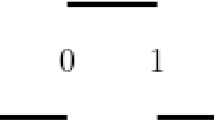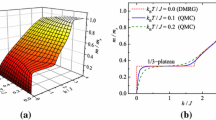Abstract
Applying the (infinite) density-matrix renormalisation group technique, we explore the effect of an explicit dimerisation on the ground-state phase diagram of the spin-1 XXZ chain with single-ion anisotropy D. We demonstrate that the Haldane phase between large-D and antiferromagnetic phases survives up to a critical dimerisation only. As a further new characteristic the dimerisation induces a direct continuous Ising quantum phase transition between the large-D and antiferromagnetic phases with central charge \(c=1/2\), which terminates at a critical end-point where \(c=7/10\). Calculating the critical exponents of the order parameter, neutral gap and spin–spin-correlation function, we find \(\beta =1/8\) (1/24), \(\nu =1\) (5/9), and \(\eta =1/4\) (3/20), respectively, which proves the Ising (tricritical Ising) universality class in accordance with field-theoretical predictions.
Similar content being viewed by others
Avoid common mistakes on your manuscript.
1 Introduction
In the last decade, quantum integer-spin chains have received revived attention from a topological point of view. In contrast to the gapless ground state in the spin-1/2 antiferromagnetic (AFM) Heisenberg chain, for integer spins there exists a finite gap between the ground state and the first excited state, as conjectured first by Haldane [1]. In the spin-1 Heisenberg chain, this so-called Haldane phase is a representative of symmetry-protected-topological (SPT) phases [2, 3], which is protected by lattice inversion, time-reversal, and dihedral (\(\mathbb {Z}_2\times \mathbb {Z}_2\)) symmetries. The Haldane phase has attracted much attention also from an experimental point of view and the Haldane gap was confirmed, e.g., in a Ni-compound Ni(C\(_2\)H\(_8\)N\(_2\))\(_2\)NO\(_2\)(ClO\(_4\)) [4, 5], which possesses a small single-ion anisotropy [6].
A natural extension of the spin-1 XXZ chain with a single-ion anisotropy is an alternating strength of the spin exchange interaction, for example, caused by a bond dimerisation, as realised in a compound again with Ni\(^{2+}\) ions [Ni(333-tet)(\(\mu \)-N\(_3\))\(_n\)](ClO\(_4\))\(_n\) [7]. We expect that such a bond dimerisation will substantially influence the ground-state properties of the spin model, just as in case of the half-filled extended Hubbard model where it opens an energy gap in the spin-density-wave regime and leads to new types of quantum phase transitions [8].
Absolute value of the AFM order parameter \(|\langle \hat{m}_\mathrm{AFM}\rangle |\) (upper row) in the vicinity of the D-LD\(\leftrightharpoons \)D-AFM Ising (a) and tricritical Ising (c) transition for \(\delta =0.1\) at fixed \(D/J=3\) and \(D/J=3.64\), respectively. Symbols are iDMRG data obtained with bond dimension \(\chi =800\), dashed lines display the fitting function with critical exponents \(\beta =1/8\) (a) and 1/24 (c). Here the relative error of the exponents is less than 7% and might be reduced further increasing the bond dimension \(\chi \). The corresponding log-log plots (b) and (d) in the lower row demonstrate that these power-laws apply with high precision close to the critical points. Here, \(\varDelta _\mathrm{c}\simeq 3.303\) and \(\varDelta _\mathrm{ce}\simeq 3.900\)
At present the most reliable method for an exact numerical treatment of one-dimensional (strongly correlated) electron, boson and spin systems seems to be the density-matrix renormalization group (DMRG) technique, which is based on a matrix-product state (MPS) approximation of the ground state [9, 10]. Here, we employ an infinite DMRG (iDMRG) variant that uses an infinite MPS representation and thus—working in the thermodynamic limit—avoids any boundary and finite-size effects [11].
2 Model and ground-state phase diagram
The Hamiltonian of a dimerised spin-1 AFM spin chain with single-ion anisotropy D reads
where \((\hat{\mathbf{S}}_j\cdot \hat{\mathbf{S}}_{j+1})_\varDelta =\hat{S}_j^x\hat{S}_{j+1}^x+\hat{S}_j^y\hat{S}_{j+1}^y +\varDelta \hat{S}_j^z\hat{S}_{j+1}^z\). For vanishing dimerisation \(\delta \) and not too large \(\varDelta \) and D/J, the ground-state phase diagram of the model (1) develops a nontrivial topological Haldane phase between topologically trivial large-D (LD) and AFM phases (see Fig. 1a). The phase transitions from Haldane to the LD and AFM phases belong to the Gaussian and Ising universality classes, respectively, while the LD\(\leftrightharpoons \)AFM transition is of first order.
A finite dimerisation strongly affects the phase boundary between the dimerised LD (D-LD) and AFM (D-AFM) phases: Now, at sufficiently large \(\varDelta \) and D/J, a new direct Ising transition appears with \(c=1/2\), which terminates at a tricritical Ising point where \(c=7/10\) [13]. Beyond this critical end-point, in the very strong-coupling regime, the quantum phase transition becomes first order (see Fig. 1b). Increasing dimerisation further, the dimerised Haldane phase (D-H) disappears at about \(\delta \gtrsim 0.26\), if we limit ourselves to the case \(J,D>0\). Figure 1c shows a situation, where only D-LD and D-AFM phases appear, for \(\delta =0.5\).
Closing of the neutral gap (upper row) at the Ising (a) and tricritical Ising (c) transition for the same parameters as in Fig. 2. The log-log plots (lower row) show that the \(L\rightarrow \infty \) extrapolated DMRG data can be excellently fitted by \(|\varDelta -\varDelta _\mathrm{c}|^\nu \) with \(\nu =1\) (b) and \(|\varDelta -\varDelta _\mathrm{ce}|^\nu \) with \(\nu =5/9\) (d)
3 Critical exponents
We now provide further evidence for Ising and tricritical Ising criticality at the D-LD\(\leftrightharpoons \)D-AFM quantum phase transition of the dimerised XXZ chain (1). Approaching a continuous quantum phase transition, the system behaviour is characterised by a set of universal exponents describing the power-law dependencies of the relevant order parameter, correlation functions or excitation gaps on \((g-g_c)\), where g parametrizes the (general) coupling constant of the model under consideration and \(g_c\) is its critical value at the transition point. Assuming the Ising (tricritical Ising) universality class, the critical exponents of the order parameter, neutral gap and spin–spin-correlation function should be \(\beta =1/8\) (1/24), \(\nu =1\) (5/9), and \(\eta =1/4\) (3/20) [14], and will be linked with each other by the scaling relation \(\tfrac{\nu }{2}(\eta +d-2)=\beta \), where d is the spatial dimension. In what follows, this will be proved for the rather complex model (1) performing unbiased iDMRG simulations. Note that it is quite challenging to determine the critical exponent, especially in the latter case, because the critical end-point itself has to be determined first with high precision by varying \(\varDelta \) and D simultaneously.
3.1 Order parameter
The exponent \(\beta \) can be extracted from the AFM order parameter:
Figure 2 displays \(|\langle \hat{m}_\mathrm{AFM}\rangle |\) across the Ising and tricritical Ising D-LD\(\leftrightharpoons \)D-AFM transitions when the spin anisotropy \(\varDelta \) is increased at fixed \(D/J=3\) and \(D/J=3.64\), respectively. The corresponding critical couplings are \(\varDelta _\mathrm{c} = 3.303\) and \(\varDelta _\mathrm{ce} = 3.900\). Evidently, the onset of \(|\langle \hat{m}_\mathrm{AFM} \rangle |\) in the D-AFM phase is much more abrupt for the transition at the critical end point. More importantly, the critical exponents of the order parameter function are verified to be 1/8 and 1/24 at the Ising transition with \(c=1/2\) and the tricritical Ising transition with \(c=7/10\), respectively.
3.2 Neutral gap
The neutral gap is defined as
where \(E_0\) (\(E_1\)) is the energy of the ground state (first excited state) for a system with L sites and vanishing total spin z-component, which is directly accessible by DMRG. To determine the neutral gap we use a DMRG representation with infinite boundary conditions [15]. Figure 3a, b shows that the neutral gap closes and opens linearly on passing the Ising transition, i.e., \(\nu =1\). Also for the tricritical Ising point the prediction of perturbed conformal field theory could be confirmed: Our data clearly yield \(\nu =5/9\), see Fig. 3c, d.
3.3 Spin–spin correlation function
Let us finally investigate the critical behaviour of the staggered z-z spin correlator \(\langle \hat{n}^z_j\hat{n}^z_{j+\ell }\rangle \) with \(\hat{n}^z_j=(-1)^j (\hat{S}^z_j-\hat{S}^z_{j+1})/2\). For this, we determine the exponent \(\eta \) from the spatial decay of the correlations at large distances \(\ell \gg 1\):
Figure 4 clearly shows that the critical exponents obtained in such a way from the iDMRG results are \(\eta =1/4\) and 3/20. That means, according to field theory, the transitions belong to the Ising respectively tricritical Ising universality class.
4 Summary
To conclude, we have examined numerically the criticality of the quantum phase transition between the dimerised large-D and antiferromagnetic phases in the spin-1 XXZ chain with explicit bond dimerisation and proved the Ising (\(c=1/2\)) and tricritical Ising (\(c=7/10\)) universality classes. The critical exponents extracted from large-scale (infinite matrix-product-state based) density-matrix renormalisation group simulations corroborate the predictions of bosonisation-based field theory, and consequently fulfil the desired scaling relation. The calculated ground-state phase diagram shows that a symmetry-protected topological Haldane phase appears—in between large-D and antiferromagnetic phases—for not too large bond dimerisation only.
We note that a similar situation evolves in the one-dimensional extended Bose–Hubbard model with bond dimerisation [16].
References
F.D.M. Haldane, Phys. Rev. Lett. 50, 1153 (1983)
Z.-C. Gu, X.-G. Wen, Phys. Rev. B 80, 155131 (2009)
F. Pollmann, A.M. Turner, E. Berg, M. Oshikawa, Phys. Rev. B 81, 064439 (2010)
W.J.L. Buyers et al., Phys. Rev. Lett. 56, 371 (1986)
J.P. Renard, M. Verdaguer, L.P. Regnault, W.A.C. Erkelens, J. Rossat-Mignod, W.G. Stirling, Europhys. Lett. 3, 945 (1987)
T. Delica, K. Kopinga, H. Leschke, K.K. Mon, Europhys. Lett. 15, 55 (1991)
M. Hagiwara, Y. Narumi, K. Kindo, M. Kohno, H. Nakano, R. Sato, M. Takahashi, Phys. Rev. Lett. 80, 1312 (1998)
S. Ejima, F.H.L. Essler, F. Lange, H. Fehske, Phys. Rev. B 93, 235118 (2016)
S.R. White, Phys. Rev. Lett. 69, 2863 (1992)
U. Schollwöck, Ann. Phys. 326, 96 (2011)
I.P. McCulloch, (n.d.). arXiv:0804.2509
S. Ejima, H. Fehske, Phys. Rev. B 91, 045121 (2015)
S. Ejima, T. Yamaguchi, F.H.L. Essler, F. Lange, Y. Ohta, H. Fehske, SciPost Phys. 5, 059 (2018)
P.D. Francesco, P. Mathieu, D. Sénéchal, Conformal Field Theory (Springer, New York, 1997)
H.N. Phien, G. Vidal, I.P. McCulloch, Phys. Rev. B 86, 245107 (2012)
K. Sugimoto, S. Ejima, F. Lange, H. Fehske, Phys. Rev. A 99, 012122 (2019)
Acknowledgements
The DMRG simulations were performed using the ITensor library [17]. S.E. and F.L. were supported by Deutsche Forschungsgemeinschaft through project EJ 7/2-1 and FE 398-1, respectively. We thank F.H.L. Essler, Y. Ohta and T. Yamaguchi for valuable discussions.
Funding
Open Access funding enabled and organized by Projekt DEAL.
Author information
Authors and Affiliations
Corresponding author
Rights and permissions
Open Access This article is licensed under a Creative Commons Attribution 4.0 International License, which permits use, sharing, adaptation, distribution and reproduction in any medium or format, as long as you give appropriate credit to the original author(s) and the source, provide a link to the Creative Commons licence, and indicate if changes were made. The images or other third party material in this article are included in the article’s Creative Commons licence, unless indicated otherwise in a credit line to the material. If material is not included in the article’s Creative Commons licence and your intended use is not permitted by statutory regulation or exceeds the permitted use, you will need to obtain permission directly from the copyright holder. To view a copy of this licence, visit http://creativecommons.org/licenses/by/4.0/.
About this article
Cite this article
Ejima, S., Lange, F. & Fehske, H. Quantum criticality in dimerised anisotropic spin-1 chains. Eur. Phys. J. Spec. Top. 230, 1009–1012 (2021). https://doi.org/10.1140/epjs/s11734-021-00060-w
Received:
Accepted:
Published:
Issue Date:
DOI: https://doi.org/10.1140/epjs/s11734-021-00060-w








